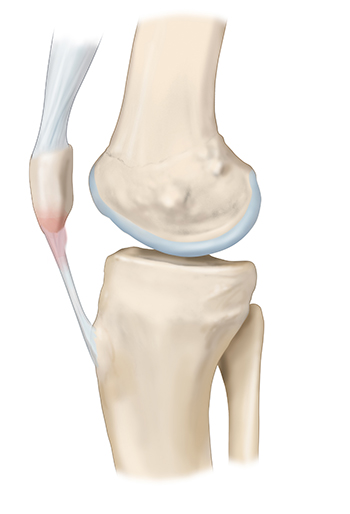Tendinitis of the Knee
The knee joint is supported by several important tendons, which play a crucial role in stabilizing and facilitating the movement of the knee. The patellar tendon connects the patella (kneecap) to the tibia (shinbone). It plays a central role in straightening the knee and is essential for activities like standing, walking, and running. The quadriceps tendon is located just above the patella and connects the quadriceps muscles in the front of the thigh to the patella. This tendon assists in extending the knee and is integral for movements such as jumping and climbing.
Tendinitis of the knee, also known as patellar or quadriceps tendinitis, is a condition characterized by inflammation and irritation of the patellar or quadriceps tendon. It is the most common cause of knee pain, especially in elite athletes such as volleyball players, basketball players, and weightlifters. It is a common condition in teen athletes and people in their 20s and 30s.

Tendinitis of the knee is caused by repetitive mechanical stress that causes micro-trauma which creates microscopic tears in the tendon and leads to tendon degeneration. Knee tendinitis often results from overuse or repetitive strain on the knee, particularly in activities like running, jumping, or sports that involve frequent knee movements. Additionally, poor biomechanics, muscle imbalances, and improper footwear can contribute to the development of patellar tendinitis or quadriceps tendinitis.
- Recreational athletes who engage in activities that require strenuous and repetitive jumping, running, or playing sports such as soccer without proper conditioning.
- Elite athletes who play jumping sports like basketball or volleyball, or any sport that involves jumping, landing, and abrupt changes in directions.
- People who are taller and heavier
- Older age and prior injuries
- Misalignment of the foot, heel, or shin bone (tibia), differences in leg length or foot arch height
- Some metabolic diseases, such as Diabetes
- Athletes who train excessively and/or train/play on hard ground
- Men are affected more often than women.
- Aching pain in the front of the knee
- Pain around the kneecap, usually felt below the kneecap if patellar tendinitis but can be felt above if quadriceps tendinitis.
- Pain that goes away with rest. The pain resolves with rest because the tendon can heal microscopic tears.
- Swelling
- Pain that recurs with prolonged sitting, squatting, and climbing stairs.
- Pain that becomes chronic with repetitive stress and can interfere with daily functions and sleep.
Knee tendinitis is a clinical diagnosis based on medical history, physical examination, and symptoms. Ultrasound can often facilitate diagnosis while MRI can sometimes confirm the presence of chronic irritation of the patellar or quadriceps tendon. Imaging studies can help to identify the severity of the degeneration.
Knee tendinitis occurs when tendons become inflamed due to repetitive stress, overuse, or improper biomechanics, leading to pain, swelling, and stiffness. Common in athletes and active individuals, knee tendinitis can interfere with movement and performance. Dr. Jorge Chahla specializes in diagnosing and treating tendinitis of the knee, offering personalized care to help patients recover and prevent further injury. If you are experiencing persistent knee pain, schedule an appointment at Dr. Chahla’s office in Chicago, Naperville, or Oak Brook for expert care.
At a Glance
Dr. Jorge Chahla
- Triple fellowship-trained sports medicine surgeon
- Performs over 700 surgeries per year
- Associate professor of orthopedic surgery at Rush University
- Learn more

